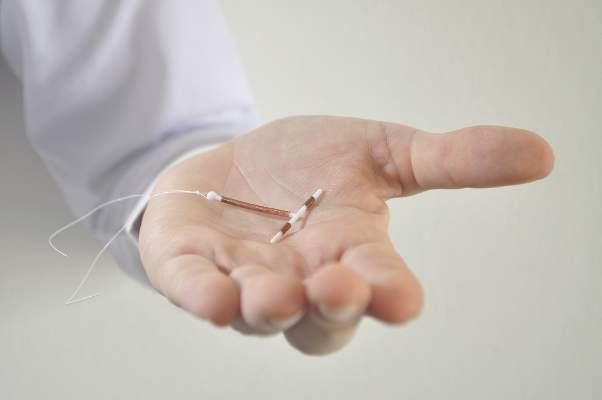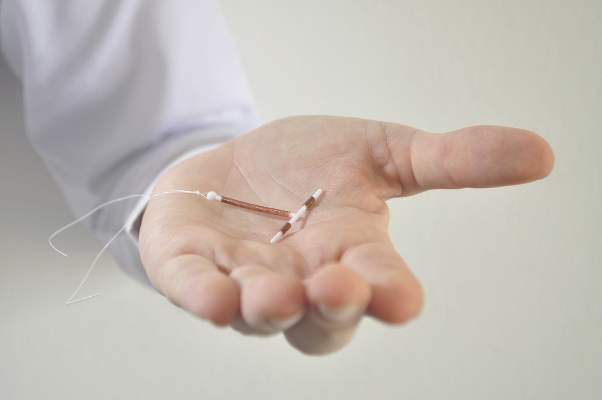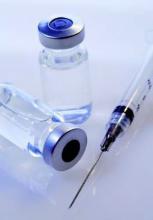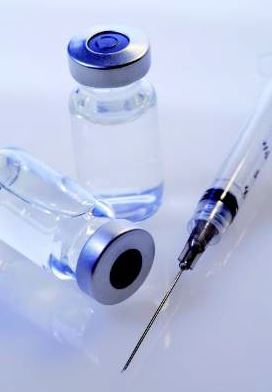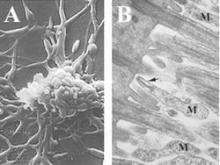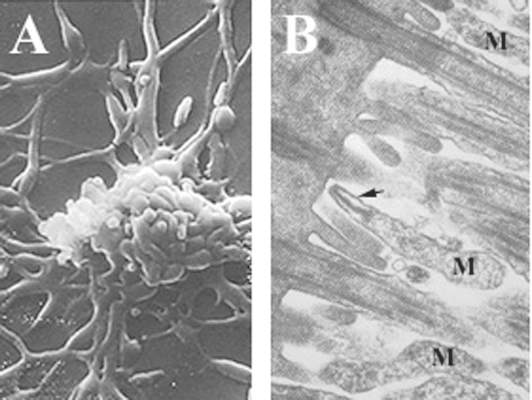User login
ACOG: Copper IUD Best for Emergency Contraception in Obese Patients
The copper intrauterine device is the most effective method of emergency contraception and may a good option for obese patients who have higher failure rates on oral emergency contraception, according to an updated practice bulletin from the American College of Obstetricians and Gynecologists.
Levonorgestrel emergency contraception may be less effective among overweight (BMI 25-29.9 kg/m2) and obese (BMI 30 kg/m2 or greater) women, and ulipristal acetate may be less effective among obese women. The copper IUD, however, is not affected by body weight.
“Consideration should be given to use of a copper IUD as an alternative to oral emergency contraception in obese women. However, oral emergency contraception should not be withheld from women who are overweight or obese because no research to date has been powered adequately to evaluate a threshold weight at which it would be ineffective,” ACOG officials wrote in a practice bulletin published on Aug. 19 (Obstet Gynecol. 2015;126:e1-11).
Among oral emergency contraception methods, ulipristal acetate is more effective than the levonorgestrel-only regimen and is effective for up to 5 days. But the levonorgestrel-only method is more effective than the combined hormonal regimen, with less nausea and vomiting.
The most common adverse effects for the pills are headache and nausea, as well as irregular menstrual bleeding. Less often reported effects include breast tenderness, abdominal pain, dizziness, and fatigue. Uterine perforation can occur in 1 of every 1,000 insertions of the copper IUD, which can also cause cramping and increased or painful menstrual flow.
The ACOG bulletin does not recommend a clinical exam or pregnancy testing before a patient uses emergency contraception. However, patients should be evaluated if their menses is delayed by a week or more after taking emergency contraception, or if they experience lower abdominal pain or persistent irregular bleeding, according to the bulletin.
The copper intrauterine device is the most effective method of emergency contraception and may a good option for obese patients who have higher failure rates on oral emergency contraception, according to an updated practice bulletin from the American College of Obstetricians and Gynecologists.
Levonorgestrel emergency contraception may be less effective among overweight (BMI 25-29.9 kg/m2) and obese (BMI 30 kg/m2 or greater) women, and ulipristal acetate may be less effective among obese women. The copper IUD, however, is not affected by body weight.
“Consideration should be given to use of a copper IUD as an alternative to oral emergency contraception in obese women. However, oral emergency contraception should not be withheld from women who are overweight or obese because no research to date has been powered adequately to evaluate a threshold weight at which it would be ineffective,” ACOG officials wrote in a practice bulletin published on Aug. 19 (Obstet Gynecol. 2015;126:e1-11).
Among oral emergency contraception methods, ulipristal acetate is more effective than the levonorgestrel-only regimen and is effective for up to 5 days. But the levonorgestrel-only method is more effective than the combined hormonal regimen, with less nausea and vomiting.
The most common adverse effects for the pills are headache and nausea, as well as irregular menstrual bleeding. Less often reported effects include breast tenderness, abdominal pain, dizziness, and fatigue. Uterine perforation can occur in 1 of every 1,000 insertions of the copper IUD, which can also cause cramping and increased or painful menstrual flow.
The ACOG bulletin does not recommend a clinical exam or pregnancy testing before a patient uses emergency contraception. However, patients should be evaluated if their menses is delayed by a week or more after taking emergency contraception, or if they experience lower abdominal pain or persistent irregular bleeding, according to the bulletin.
The copper intrauterine device is the most effective method of emergency contraception and may a good option for obese patients who have higher failure rates on oral emergency contraception, according to an updated practice bulletin from the American College of Obstetricians and Gynecologists.
Levonorgestrel emergency contraception may be less effective among overweight (BMI 25-29.9 kg/m2) and obese (BMI 30 kg/m2 or greater) women, and ulipristal acetate may be less effective among obese women. The copper IUD, however, is not affected by body weight.
“Consideration should be given to use of a copper IUD as an alternative to oral emergency contraception in obese women. However, oral emergency contraception should not be withheld from women who are overweight or obese because no research to date has been powered adequately to evaluate a threshold weight at which it would be ineffective,” ACOG officials wrote in a practice bulletin published on Aug. 19 (Obstet Gynecol. 2015;126:e1-11).
Among oral emergency contraception methods, ulipristal acetate is more effective than the levonorgestrel-only regimen and is effective for up to 5 days. But the levonorgestrel-only method is more effective than the combined hormonal regimen, with less nausea and vomiting.
The most common adverse effects for the pills are headache and nausea, as well as irregular menstrual bleeding. Less often reported effects include breast tenderness, abdominal pain, dizziness, and fatigue. Uterine perforation can occur in 1 of every 1,000 insertions of the copper IUD, which can also cause cramping and increased or painful menstrual flow.
The ACOG bulletin does not recommend a clinical exam or pregnancy testing before a patient uses emergency contraception. However, patients should be evaluated if their menses is delayed by a week or more after taking emergency contraception, or if they experience lower abdominal pain or persistent irregular bleeding, according to the bulletin.
FROM AN ACOG PRACTICE BULLETIN
ACOG: Copper IUD best for emergency contraception in obese patients
The copper intrauterine device is the most effective method of emergency contraception and may a good option for obese patients who have higher failure rates on oral emergency contraception, according to an updated practice bulletin from the American College of Obstetricians and Gynecologists.
Levonorgestrel emergency contraception may be less effective among overweight (BMI 25-29.9 kg/m2) and obese (BMI 30 kg/m2 or greater) women, and ulipristal acetate may be less effective among obese women. The copper IUD, however, is not affected by body weight.
“Consideration should be given to use of a copper IUD as an alternative to oral emergency contraception in obese women. However, oral emergency contraception should not be withheld from women who are overweight or obese because no research to date has been powered adequately to evaluate a threshold weight at which it would be ineffective,” ACOG officials wrote in a practice bulletin published on Aug. 19 (Obstet Gynecol. 2015;126:e1-11).
Among oral emergency contraception methods, ulipristal acetate is more effective than the levonorgestrel-only regimen and is effective for up to 5 days. But the levonorgestrel-only method is more effective than the combined hormonal regimen, with less nausea and vomiting.
The most common adverse effects for the pills are headache and nausea, as well as irregular menstrual bleeding. Less often reported effects include breast tenderness, abdominal pain, dizziness, and fatigue. Uterine perforation can occur in 1 of every 1,000 insertions of the copper IUD, which can also cause cramping and increased or painful menstrual flow.
The ACOG bulletin does not recommend a clinical exam or pregnancy testing before a patient uses emergency contraception. However, patients should be evaluated if their menses is delayed by a week or more after taking emergency contraception, or if they experience lower abdominal pain or persistent irregular bleeding, according to the bulletin.
The copper intrauterine device is the most effective method of emergency contraception and may a good option for obese patients who have higher failure rates on oral emergency contraception, according to an updated practice bulletin from the American College of Obstetricians and Gynecologists.
Levonorgestrel emergency contraception may be less effective among overweight (BMI 25-29.9 kg/m2) and obese (BMI 30 kg/m2 or greater) women, and ulipristal acetate may be less effective among obese women. The copper IUD, however, is not affected by body weight.
“Consideration should be given to use of a copper IUD as an alternative to oral emergency contraception in obese women. However, oral emergency contraception should not be withheld from women who are overweight or obese because no research to date has been powered adequately to evaluate a threshold weight at which it would be ineffective,” ACOG officials wrote in a practice bulletin published on Aug. 19 (Obstet Gynecol. 2015;126:e1-11).
Among oral emergency contraception methods, ulipristal acetate is more effective than the levonorgestrel-only regimen and is effective for up to 5 days. But the levonorgestrel-only method is more effective than the combined hormonal regimen, with less nausea and vomiting.
The most common adverse effects for the pills are headache and nausea, as well as irregular menstrual bleeding. Less often reported effects include breast tenderness, abdominal pain, dizziness, and fatigue. Uterine perforation can occur in 1 of every 1,000 insertions of the copper IUD, which can also cause cramping and increased or painful menstrual flow.
The ACOG bulletin does not recommend a clinical exam or pregnancy testing before a patient uses emergency contraception. However, patients should be evaluated if their menses is delayed by a week or more after taking emergency contraception, or if they experience lower abdominal pain or persistent irregular bleeding, according to the bulletin.
The copper intrauterine device is the most effective method of emergency contraception and may a good option for obese patients who have higher failure rates on oral emergency contraception, according to an updated practice bulletin from the American College of Obstetricians and Gynecologists.
Levonorgestrel emergency contraception may be less effective among overweight (BMI 25-29.9 kg/m2) and obese (BMI 30 kg/m2 or greater) women, and ulipristal acetate may be less effective among obese women. The copper IUD, however, is not affected by body weight.
“Consideration should be given to use of a copper IUD as an alternative to oral emergency contraception in obese women. However, oral emergency contraception should not be withheld from women who are overweight or obese because no research to date has been powered adequately to evaluate a threshold weight at which it would be ineffective,” ACOG officials wrote in a practice bulletin published on Aug. 19 (Obstet Gynecol. 2015;126:e1-11).
Among oral emergency contraception methods, ulipristal acetate is more effective than the levonorgestrel-only regimen and is effective for up to 5 days. But the levonorgestrel-only method is more effective than the combined hormonal regimen, with less nausea and vomiting.
The most common adverse effects for the pills are headache and nausea, as well as irregular menstrual bleeding. Less often reported effects include breast tenderness, abdominal pain, dizziness, and fatigue. Uterine perforation can occur in 1 of every 1,000 insertions of the copper IUD, which can also cause cramping and increased or painful menstrual flow.
The ACOG bulletin does not recommend a clinical exam or pregnancy testing before a patient uses emergency contraception. However, patients should be evaluated if their menses is delayed by a week or more after taking emergency contraception, or if they experience lower abdominal pain or persistent irregular bleeding, according to the bulletin.
FROM AN ACOG PRACTICE BULLETIN
ACOG offers advice on early treatment of morning sickness
Physicians should consider early treatment of nausea and vomiting in pregnancy to prevent progression to hyperemesis gravidarum, according to an updated practice bulletin from the American College of Obstetricians and Gynecologists.
Recommendations with the strongest evidence for prevention and management of nausea and vomiting in pregnancy include taking prenatal vitamins for 3 months prior to conception, and treating nausea and vomiting with vitamin B6 or vitamin B6 plus doxylamine.
Patients with hyperemesis gravidarum (HG) and suppressed thyroid-stimulating hormone levels should not receive hyperthyroidism treatment until evidence of thyroid disease has been clearly identified, according to the bulletin published on Aug. 19 (Obstet Gynecol. 2015;126:e12–24).
Though the evidence is weaker, women can also use ginger to ease nausea symptoms. Women experiencing particularly unmanageable nausea and vomiting or HG may find methylprednisolone, 48 mg taken daily orally or intravenously for 3 days, effective in reducing symptoms. But its efficacy is unclear, and it may increase the risk of oral clefts by one or two cases per 1,000 treated women. For this reason, ACOG urged physicians to use caution in prescribing the drug for HG and to avoid it as a first-line agent before 10 weeks gestation.
“Treatment of severe nausea and vomiting of pregnancy or hyperemesis gravidarum with methylprednisolone may be efficacious in refractory cases; however, the risk profile of methylprednisolone suggests it should be a last-resort treatment,” ACOG wrote.
Consensus and expert opinion support the recommendation to use IV hydration for women with HG who are dehydrated or cannot tolerate oral liquids.
“Dextrose and vitamins should be included in the therapy when prolonged vomiting is present, and thiamine should be administered before dextrose infusion to prevent Wernicke encephalopathy,” ACOG recommended.
Women with HG who cannot maintain their weight or do not respond to medical therapy may require enteral tube feeding for nutrition. These women should not receive peripherally inserted central catheters unless absolutely necessary because of the risk of complications.
About half of all pregnant women experience vomiting, and up to 80% experience nausea while pregnant, though only about 0.3%-3% of pregnancies progress to HG, according to ACOG. Although HG, typically diagnosed once other causes have been excluded, lacks clear criteria, it commonly includes at least 5% loss of prepregnancy weight, persistent vomiting not related to other causes, and some measure of acute starvation, such as large ketonuria. There may also be electrolyte, thyroid, and liver abnormalities.
While one study has categorized the severity of nausea and vomiting in pregnancy along a continuum, the most clinically relevant factor is how the patient is affected by her symptoms.
“The woman’s perception of the severity of her symptoms, her desire for treatment, and the potential effect of treatment on her fetus are more likely to influence clinical decision making,” the bulletin states.
The recommendations in the bulletin are based on a literature search between January 1985 and April 2015 of English-language articles in the MEDLINE database, Cochrane Library, and the American College of Obstetricians and Gynecologists’ internal resources and documents.
Physicians should consider early treatment of nausea and vomiting in pregnancy to prevent progression to hyperemesis gravidarum, according to an updated practice bulletin from the American College of Obstetricians and Gynecologists.
Recommendations with the strongest evidence for prevention and management of nausea and vomiting in pregnancy include taking prenatal vitamins for 3 months prior to conception, and treating nausea and vomiting with vitamin B6 or vitamin B6 plus doxylamine.
Patients with hyperemesis gravidarum (HG) and suppressed thyroid-stimulating hormone levels should not receive hyperthyroidism treatment until evidence of thyroid disease has been clearly identified, according to the bulletin published on Aug. 19 (Obstet Gynecol. 2015;126:e12–24).
Though the evidence is weaker, women can also use ginger to ease nausea symptoms. Women experiencing particularly unmanageable nausea and vomiting or HG may find methylprednisolone, 48 mg taken daily orally or intravenously for 3 days, effective in reducing symptoms. But its efficacy is unclear, and it may increase the risk of oral clefts by one or two cases per 1,000 treated women. For this reason, ACOG urged physicians to use caution in prescribing the drug for HG and to avoid it as a first-line agent before 10 weeks gestation.
“Treatment of severe nausea and vomiting of pregnancy or hyperemesis gravidarum with methylprednisolone may be efficacious in refractory cases; however, the risk profile of methylprednisolone suggests it should be a last-resort treatment,” ACOG wrote.
Consensus and expert opinion support the recommendation to use IV hydration for women with HG who are dehydrated or cannot tolerate oral liquids.
“Dextrose and vitamins should be included in the therapy when prolonged vomiting is present, and thiamine should be administered before dextrose infusion to prevent Wernicke encephalopathy,” ACOG recommended.
Women with HG who cannot maintain their weight or do not respond to medical therapy may require enteral tube feeding for nutrition. These women should not receive peripherally inserted central catheters unless absolutely necessary because of the risk of complications.
About half of all pregnant women experience vomiting, and up to 80% experience nausea while pregnant, though only about 0.3%-3% of pregnancies progress to HG, according to ACOG. Although HG, typically diagnosed once other causes have been excluded, lacks clear criteria, it commonly includes at least 5% loss of prepregnancy weight, persistent vomiting not related to other causes, and some measure of acute starvation, such as large ketonuria. There may also be electrolyte, thyroid, and liver abnormalities.
While one study has categorized the severity of nausea and vomiting in pregnancy along a continuum, the most clinically relevant factor is how the patient is affected by her symptoms.
“The woman’s perception of the severity of her symptoms, her desire for treatment, and the potential effect of treatment on her fetus are more likely to influence clinical decision making,” the bulletin states.
The recommendations in the bulletin are based on a literature search between January 1985 and April 2015 of English-language articles in the MEDLINE database, Cochrane Library, and the American College of Obstetricians and Gynecologists’ internal resources and documents.
Physicians should consider early treatment of nausea and vomiting in pregnancy to prevent progression to hyperemesis gravidarum, according to an updated practice bulletin from the American College of Obstetricians and Gynecologists.
Recommendations with the strongest evidence for prevention and management of nausea and vomiting in pregnancy include taking prenatal vitamins for 3 months prior to conception, and treating nausea and vomiting with vitamin B6 or vitamin B6 plus doxylamine.
Patients with hyperemesis gravidarum (HG) and suppressed thyroid-stimulating hormone levels should not receive hyperthyroidism treatment until evidence of thyroid disease has been clearly identified, according to the bulletin published on Aug. 19 (Obstet Gynecol. 2015;126:e12–24).
Though the evidence is weaker, women can also use ginger to ease nausea symptoms. Women experiencing particularly unmanageable nausea and vomiting or HG may find methylprednisolone, 48 mg taken daily orally or intravenously for 3 days, effective in reducing symptoms. But its efficacy is unclear, and it may increase the risk of oral clefts by one or two cases per 1,000 treated women. For this reason, ACOG urged physicians to use caution in prescribing the drug for HG and to avoid it as a first-line agent before 10 weeks gestation.
“Treatment of severe nausea and vomiting of pregnancy or hyperemesis gravidarum with methylprednisolone may be efficacious in refractory cases; however, the risk profile of methylprednisolone suggests it should be a last-resort treatment,” ACOG wrote.
Consensus and expert opinion support the recommendation to use IV hydration for women with HG who are dehydrated or cannot tolerate oral liquids.
“Dextrose and vitamins should be included in the therapy when prolonged vomiting is present, and thiamine should be administered before dextrose infusion to prevent Wernicke encephalopathy,” ACOG recommended.
Women with HG who cannot maintain their weight or do not respond to medical therapy may require enteral tube feeding for nutrition. These women should not receive peripherally inserted central catheters unless absolutely necessary because of the risk of complications.
About half of all pregnant women experience vomiting, and up to 80% experience nausea while pregnant, though only about 0.3%-3% of pregnancies progress to HG, according to ACOG. Although HG, typically diagnosed once other causes have been excluded, lacks clear criteria, it commonly includes at least 5% loss of prepregnancy weight, persistent vomiting not related to other causes, and some measure of acute starvation, such as large ketonuria. There may also be electrolyte, thyroid, and liver abnormalities.
While one study has categorized the severity of nausea and vomiting in pregnancy along a continuum, the most clinically relevant factor is how the patient is affected by her symptoms.
“The woman’s perception of the severity of her symptoms, her desire for treatment, and the potential effect of treatment on her fetus are more likely to influence clinical decision making,” the bulletin states.
The recommendations in the bulletin are based on a literature search between January 1985 and April 2015 of English-language articles in the MEDLINE database, Cochrane Library, and the American College of Obstetricians and Gynecologists’ internal resources and documents.
FROM AN ACOG PRACTICE BULLETIN
IVF births comprise large proportion of multiple, preterm births
Approximately 1.5% of all infants born in the United States in 2012 were conceived using assisted reproductive technology, predominantly in vitro fertilization, according to a report published Aug. 14 by the Centers for Disease Control and Prevention.
The highest birth rates from ART – 3% or more of all births – were found in Connecticut, Massachusetts, New Jersey, and the District of Columbia. Nearly one in five multiple births (19.6%) resulted from use of ART.
“In most reporting areas, multiples from ART comprised a substantial proportion of all twin, triplet, and higher-order infants born, and the rates of low-birth-weight and preterm infants were disproportionately higher among ART infants than in the birth population overall,” reported Saswati Sunderam, Ph.D., and associates at the CDC’s Division of Reproductive Health at the National Center for Chronic Disease Prevention.
A total of 157,635 ART procedures were performed in 456 U.S. fertility clinics in 2012, resulting in 51,261 live-birth deliveries and 65,151 newborns, according to data from all 50 states plus the District of Columbia and Puerto Rico that were reported to the National ART Surveillance System. The 456 clinics represent 94% of all U.S. fertility clinics. (MMWR Surveill Summ. 2015 Aug 14;64[Suppl 6]:1-29).
Approximately 2,483 women per 1 million women aged 15-44 years used ART in 2012, with the rates more than double this in Massachusetts, New Jersey and the District of Columbia. Six states accounted for half (50.1%) of all ART procedures performed: California, New York, Illinois, Texas, Massachusetts, and New Jersey. These states’ births comprised 48% of all deliveries and 48% of all infants born from ART.
Among patients using fresh embryos from their own eggs, an average of 1.9 embryos were transferred to women under age 35 while an average of 2.2 were transferred for women aged 35-40 years, and an average of 2.7 for women over age 40. Approximately 15% of women nationally used elective single-embryo transfers, ranging from 2.1% of procedures in Oklahoma to 60% of those in Delaware.
Triplets or higher-order multiples conceived from ART represented 30% of all triplet and higher-order births in 2012. Nearly a third of ART-conceived infants (30%) were low birth weight, compared with 8% among all infants, and 6% of infants conceived with ART were very low birth weight, compared with 1.4% of all infants.
Just over a third of ART-conceived infants (35%) were born preterm, compared with 12% in the general population.
Overall, infants conceived with ART comprised 4.6% of all preterm infants, 5.2% of all very-preterm infants, 5.7% of all low-birth-weight infants and 5.8% of all very-low-birth-weight infants.
Approximately 1.5% of all infants born in the United States in 2012 were conceived using assisted reproductive technology, predominantly in vitro fertilization, according to a report published Aug. 14 by the Centers for Disease Control and Prevention.
The highest birth rates from ART – 3% or more of all births – were found in Connecticut, Massachusetts, New Jersey, and the District of Columbia. Nearly one in five multiple births (19.6%) resulted from use of ART.
“In most reporting areas, multiples from ART comprised a substantial proportion of all twin, triplet, and higher-order infants born, and the rates of low-birth-weight and preterm infants were disproportionately higher among ART infants than in the birth population overall,” reported Saswati Sunderam, Ph.D., and associates at the CDC’s Division of Reproductive Health at the National Center for Chronic Disease Prevention.
A total of 157,635 ART procedures were performed in 456 U.S. fertility clinics in 2012, resulting in 51,261 live-birth deliveries and 65,151 newborns, according to data from all 50 states plus the District of Columbia and Puerto Rico that were reported to the National ART Surveillance System. The 456 clinics represent 94% of all U.S. fertility clinics. (MMWR Surveill Summ. 2015 Aug 14;64[Suppl 6]:1-29).
Approximately 2,483 women per 1 million women aged 15-44 years used ART in 2012, with the rates more than double this in Massachusetts, New Jersey and the District of Columbia. Six states accounted for half (50.1%) of all ART procedures performed: California, New York, Illinois, Texas, Massachusetts, and New Jersey. These states’ births comprised 48% of all deliveries and 48% of all infants born from ART.
Among patients using fresh embryos from their own eggs, an average of 1.9 embryos were transferred to women under age 35 while an average of 2.2 were transferred for women aged 35-40 years, and an average of 2.7 for women over age 40. Approximately 15% of women nationally used elective single-embryo transfers, ranging from 2.1% of procedures in Oklahoma to 60% of those in Delaware.
Triplets or higher-order multiples conceived from ART represented 30% of all triplet and higher-order births in 2012. Nearly a third of ART-conceived infants (30%) were low birth weight, compared with 8% among all infants, and 6% of infants conceived with ART were very low birth weight, compared with 1.4% of all infants.
Just over a third of ART-conceived infants (35%) were born preterm, compared with 12% in the general population.
Overall, infants conceived with ART comprised 4.6% of all preterm infants, 5.2% of all very-preterm infants, 5.7% of all low-birth-weight infants and 5.8% of all very-low-birth-weight infants.
Approximately 1.5% of all infants born in the United States in 2012 were conceived using assisted reproductive technology, predominantly in vitro fertilization, according to a report published Aug. 14 by the Centers for Disease Control and Prevention.
The highest birth rates from ART – 3% or more of all births – were found in Connecticut, Massachusetts, New Jersey, and the District of Columbia. Nearly one in five multiple births (19.6%) resulted from use of ART.
“In most reporting areas, multiples from ART comprised a substantial proportion of all twin, triplet, and higher-order infants born, and the rates of low-birth-weight and preterm infants were disproportionately higher among ART infants than in the birth population overall,” reported Saswati Sunderam, Ph.D., and associates at the CDC’s Division of Reproductive Health at the National Center for Chronic Disease Prevention.
A total of 157,635 ART procedures were performed in 456 U.S. fertility clinics in 2012, resulting in 51,261 live-birth deliveries and 65,151 newborns, according to data from all 50 states plus the District of Columbia and Puerto Rico that were reported to the National ART Surveillance System. The 456 clinics represent 94% of all U.S. fertility clinics. (MMWR Surveill Summ. 2015 Aug 14;64[Suppl 6]:1-29).
Approximately 2,483 women per 1 million women aged 15-44 years used ART in 2012, with the rates more than double this in Massachusetts, New Jersey and the District of Columbia. Six states accounted for half (50.1%) of all ART procedures performed: California, New York, Illinois, Texas, Massachusetts, and New Jersey. These states’ births comprised 48% of all deliveries and 48% of all infants born from ART.
Among patients using fresh embryos from their own eggs, an average of 1.9 embryos were transferred to women under age 35 while an average of 2.2 were transferred for women aged 35-40 years, and an average of 2.7 for women over age 40. Approximately 15% of women nationally used elective single-embryo transfers, ranging from 2.1% of procedures in Oklahoma to 60% of those in Delaware.
Triplets or higher-order multiples conceived from ART represented 30% of all triplet and higher-order births in 2012. Nearly a third of ART-conceived infants (30%) were low birth weight, compared with 8% among all infants, and 6% of infants conceived with ART were very low birth weight, compared with 1.4% of all infants.
Just over a third of ART-conceived infants (35%) were born preterm, compared with 12% in the general population.
Overall, infants conceived with ART comprised 4.6% of all preterm infants, 5.2% of all very-preterm infants, 5.7% of all low-birth-weight infants and 5.8% of all very-low-birth-weight infants.
FROM MORBIDITY AND MORTALITY WEEKLY REPORT
Key clinical point: 1.5% of all U.S. infants are born with assisted reproductive technology.
Major finding: ART-conceived infants comprised 19.6% of all multiple-birth infants in 2012; among ART-conceived infants, 30% were low birth weight, and 35% were born preterm.
Data source: National ART Surveillance System 2012 data, including reporting from all 50 states plus the District of Columbia and Puerto Rico.
Disclosures: The research was supported by the Centers for Disease Control and Prevention. The authors reported no conflicts of interest.
New HPV vaccine safe with meningitis, Tdap vaccines
Children and adolescents receiving the 9-valent human papillomavirus vaccine Gardasil 9 along with the Menactra meningococcal vaccine and a Tdap booster at the same visit do not experience decreased effectiveness or safety from any of the vaccines, a study showed.
The titers from all three vaccines were noninferior when administered together, compared with administration of the Tdap (tetanus, diphtheria, and acellular pertussis) and the meningococcal vaccine a month after the first HPV-9 dose. Adverse events also were similar across both groups, except injection-site reactions were more common in those receiving all three vaccines together initially.
“Providing vaccinations to adolescents is challenging because they make infrequent health care visits,” wrote Dr. Andrea Schilling of Alemana-Universidad del Desarrollo in Santiago, Chile, and her associates. “Concomitant administration would minimize the number of visits required to deliver each vaccine individually and therefore facilitate adherence to recommended vaccination regimens.”
Boys and girls aged 11-15 who self-reported as sexually naive in Chile, Colombia, Mexico, Peru, and the United States received recommended vaccines between October 2009 and February 2011. Among the 1,241 participants who received the 9-valent HPV vaccine, 621 of them received the Menactra meningococcal vaccine, covering Neisseria meningitidis serotypes A, C, Y, and W-135 (MCV4), and Tdap vaccines at the same visit. The other 620 participants received the MCV4 and Tdap vaccines 1 month after the HPV vaccine dose (Pediatrics. doi: 10.1542/peds.2014-4199).
Both groups showed similar levels of geometric mean titers for all nine HPV types included in Gardasil 9, all four N. meningitidis serotypes included in MCV4, and diphtheria, tetanus, and pertussis 4 weeks after the third dose of Gardasil 9. Both groups had 100% seroconversion for all HPV types at 7 months after the first dose. In addition, at least 75% of participants in both groups showed at least a fourfold increase in titers to N. meningitidis serogroup A, and at least 89% in both groups showed a fourfold increase for serogroups C, Y, and W-135. Finally, at least 99.8% of participants across both groups had at least 0.1 IU/mL diphtheria and tetanus titers 4 weeks after the Tdap booster. Antibodies to pertussis proteins were likewise noninferior in the concomitant group, compared with the nonconcomitant group.
The most commonly reported adverse events were pain, redness, or swelling at the injection site, reported by 85.3% of those receiving all three vaccines in the same visit and by 85.1% of those receiving the Tdap and MCV4 after the 9-valent HPV vaccine. However, 14.4% of those who received all the vaccines together reported swelling at the injection site, compared with 9.4% of those who received the MCV4 and Tdap a month after the HPV-9. The authors said that the higher rate for combined administration was attributable to the concomitant administration of the Tdap with the HPV vaccine. Otherwise, 0.8% of participants in both groups reported serious adverse events, all deemed unrelated to the vaccine.
“In the United States, coverage for the first dose of HPV vaccine remains substantially lower (by 20-25 percentage points) than coverage for other vaccines recommended by the Advisory Committee on Immunization Practices for children 11-12 years of age,” the authors wrote. “It is estimated that coadministration of HPV vaccine with other vaccines, such as diphtheria, tetanus, pertussis, meningococcal conjugate, and influenza vaccines, could increase coverage for the first dose of HPV vaccine to more than 90%.”
The investigators said the main limitation of the study was that it was not blinded. “As such, safety assessment could have been biased toward an overestimation of [adverse events],” they wrote.
The research was funded by Merck & Co. Dr. Schilling reported receiving past research support from Merck and honoraria from Merck-Chile, Grunenthal-Chile, and Grunenthal-L.A. Her associates reported financial relationships with numerous pharmaceutical companies.
Children and adolescents receiving the 9-valent human papillomavirus vaccine Gardasil 9 along with the Menactra meningococcal vaccine and a Tdap booster at the same visit do not experience decreased effectiveness or safety from any of the vaccines, a study showed.
The titers from all three vaccines were noninferior when administered together, compared with administration of the Tdap (tetanus, diphtheria, and acellular pertussis) and the meningococcal vaccine a month after the first HPV-9 dose. Adverse events also were similar across both groups, except injection-site reactions were more common in those receiving all three vaccines together initially.
“Providing vaccinations to adolescents is challenging because they make infrequent health care visits,” wrote Dr. Andrea Schilling of Alemana-Universidad del Desarrollo in Santiago, Chile, and her associates. “Concomitant administration would minimize the number of visits required to deliver each vaccine individually and therefore facilitate adherence to recommended vaccination regimens.”
Boys and girls aged 11-15 who self-reported as sexually naive in Chile, Colombia, Mexico, Peru, and the United States received recommended vaccines between October 2009 and February 2011. Among the 1,241 participants who received the 9-valent HPV vaccine, 621 of them received the Menactra meningococcal vaccine, covering Neisseria meningitidis serotypes A, C, Y, and W-135 (MCV4), and Tdap vaccines at the same visit. The other 620 participants received the MCV4 and Tdap vaccines 1 month after the HPV vaccine dose (Pediatrics. doi: 10.1542/peds.2014-4199).
Both groups showed similar levels of geometric mean titers for all nine HPV types included in Gardasil 9, all four N. meningitidis serotypes included in MCV4, and diphtheria, tetanus, and pertussis 4 weeks after the third dose of Gardasil 9. Both groups had 100% seroconversion for all HPV types at 7 months after the first dose. In addition, at least 75% of participants in both groups showed at least a fourfold increase in titers to N. meningitidis serogroup A, and at least 89% in both groups showed a fourfold increase for serogroups C, Y, and W-135. Finally, at least 99.8% of participants across both groups had at least 0.1 IU/mL diphtheria and tetanus titers 4 weeks after the Tdap booster. Antibodies to pertussis proteins were likewise noninferior in the concomitant group, compared with the nonconcomitant group.
The most commonly reported adverse events were pain, redness, or swelling at the injection site, reported by 85.3% of those receiving all three vaccines in the same visit and by 85.1% of those receiving the Tdap and MCV4 after the 9-valent HPV vaccine. However, 14.4% of those who received all the vaccines together reported swelling at the injection site, compared with 9.4% of those who received the MCV4 and Tdap a month after the HPV-9. The authors said that the higher rate for combined administration was attributable to the concomitant administration of the Tdap with the HPV vaccine. Otherwise, 0.8% of participants in both groups reported serious adverse events, all deemed unrelated to the vaccine.
“In the United States, coverage for the first dose of HPV vaccine remains substantially lower (by 20-25 percentage points) than coverage for other vaccines recommended by the Advisory Committee on Immunization Practices for children 11-12 years of age,” the authors wrote. “It is estimated that coadministration of HPV vaccine with other vaccines, such as diphtheria, tetanus, pertussis, meningococcal conjugate, and influenza vaccines, could increase coverage for the first dose of HPV vaccine to more than 90%.”
The investigators said the main limitation of the study was that it was not blinded. “As such, safety assessment could have been biased toward an overestimation of [adverse events],” they wrote.
The research was funded by Merck & Co. Dr. Schilling reported receiving past research support from Merck and honoraria from Merck-Chile, Grunenthal-Chile, and Grunenthal-L.A. Her associates reported financial relationships with numerous pharmaceutical companies.
Children and adolescents receiving the 9-valent human papillomavirus vaccine Gardasil 9 along with the Menactra meningococcal vaccine and a Tdap booster at the same visit do not experience decreased effectiveness or safety from any of the vaccines, a study showed.
The titers from all three vaccines were noninferior when administered together, compared with administration of the Tdap (tetanus, diphtheria, and acellular pertussis) and the meningococcal vaccine a month after the first HPV-9 dose. Adverse events also were similar across both groups, except injection-site reactions were more common in those receiving all three vaccines together initially.
“Providing vaccinations to adolescents is challenging because they make infrequent health care visits,” wrote Dr. Andrea Schilling of Alemana-Universidad del Desarrollo in Santiago, Chile, and her associates. “Concomitant administration would minimize the number of visits required to deliver each vaccine individually and therefore facilitate adherence to recommended vaccination regimens.”
Boys and girls aged 11-15 who self-reported as sexually naive in Chile, Colombia, Mexico, Peru, and the United States received recommended vaccines between October 2009 and February 2011. Among the 1,241 participants who received the 9-valent HPV vaccine, 621 of them received the Menactra meningococcal vaccine, covering Neisseria meningitidis serotypes A, C, Y, and W-135 (MCV4), and Tdap vaccines at the same visit. The other 620 participants received the MCV4 and Tdap vaccines 1 month after the HPV vaccine dose (Pediatrics. doi: 10.1542/peds.2014-4199).
Both groups showed similar levels of geometric mean titers for all nine HPV types included in Gardasil 9, all four N. meningitidis serotypes included in MCV4, and diphtheria, tetanus, and pertussis 4 weeks after the third dose of Gardasil 9. Both groups had 100% seroconversion for all HPV types at 7 months after the first dose. In addition, at least 75% of participants in both groups showed at least a fourfold increase in titers to N. meningitidis serogroup A, and at least 89% in both groups showed a fourfold increase for serogroups C, Y, and W-135. Finally, at least 99.8% of participants across both groups had at least 0.1 IU/mL diphtheria and tetanus titers 4 weeks after the Tdap booster. Antibodies to pertussis proteins were likewise noninferior in the concomitant group, compared with the nonconcomitant group.
The most commonly reported adverse events were pain, redness, or swelling at the injection site, reported by 85.3% of those receiving all three vaccines in the same visit and by 85.1% of those receiving the Tdap and MCV4 after the 9-valent HPV vaccine. However, 14.4% of those who received all the vaccines together reported swelling at the injection site, compared with 9.4% of those who received the MCV4 and Tdap a month after the HPV-9. The authors said that the higher rate for combined administration was attributable to the concomitant administration of the Tdap with the HPV vaccine. Otherwise, 0.8% of participants in both groups reported serious adverse events, all deemed unrelated to the vaccine.
“In the United States, coverage for the first dose of HPV vaccine remains substantially lower (by 20-25 percentage points) than coverage for other vaccines recommended by the Advisory Committee on Immunization Practices for children 11-12 years of age,” the authors wrote. “It is estimated that coadministration of HPV vaccine with other vaccines, such as diphtheria, tetanus, pertussis, meningococcal conjugate, and influenza vaccines, could increase coverage for the first dose of HPV vaccine to more than 90%.”
The investigators said the main limitation of the study was that it was not blinded. “As such, safety assessment could have been biased toward an overestimation of [adverse events],” they wrote.
The research was funded by Merck & Co. Dr. Schilling reported receiving past research support from Merck and honoraria from Merck-Chile, Grunenthal-Chile, and Grunenthal-L.A. Her associates reported financial relationships with numerous pharmaceutical companies.
FROM PEDIATRICS
Key clinical point: The new 9-valent HPV vaccine can be given with other standard vaccines in one visit.
Major finding: No difference in safety or effectiveness was seen with coadministration of HPV-9, Tdap booster, and Menactra vaccines.
Data source: An open-label, randomized, multicenter comparative study involving 1,241 boys and girls, aged 11-15, who received the 9-valent HPV vaccine along with the Tdap booster and Menactra vaccines.
Disclosures: The research was funded by Merck & Co. Dr. Schilling reported receiving past research support from Merck and honoraria from Merck-Chile, Grunenthal-Chile, and Grunenthal-L.A. Her associates reported financial relationships with numerous pharmaceutical companies.
New autism screening tool is fast, accurate
An interactive level 2 screening test for autism spectrum disorders in toddlers takes only 5-10 minutes to administer, providing an option that might improve early identification of the developmental condition, a new study suggests.
Dr. Roula N. Choueiri of University of Massachusetts Memorial Children’s Medical Center in Worcester, and of Sheldon H. Wagner, Ph.D., of the Behavioral Development and Educational Services in New Bedford, Mass., said the Rapid Interactive Screening Test for Autism in Toddlers (RITA-T) “could greatly expand the availability of effective level 2 ASD screening measures, which would lead to earlier diagnosis of ASD and access to treatment” (J Pediatr. 2015 Aug;167(2):460-466 doi:10.1016/j.jpeds.2015.05.029).
“There is an important need for a psychometrically valid and interactive level 2 ASD screening test that is both easily learned and readily administered by clinicians in busy clinical settings and early-intervention programs,” the authors wrote. Training to administer and score their RITA-T requires about 3 hours in small groups, and the authors plan for the tool to exist in the public domain once further validated.
Because level 1 screenings, such as the Modified Checklist for Autism in Toddlers (M-CHAT) have high false-positive rates, level 2 assessments can confirm risk of ASD when doctors screen toddlers between 18 and 24 months old. The two existing level 2 screening tests include the Systematic Observation for Red Flags (SORF), which requires videotaping, and the Screening Tool for Autism in Two-Year-Olds (STAT), which requires 20 minutes to administer.
The RITA-T involves nine interactive activities aimed at assessing toddlers’ joint attention, social awareness, reaction to emotions, awareness of human agency, and several basic cognitive skills. Each activity assigns points for a child’s behaving differently than expected, for a total possible high score of 30, indicating the most atypical development.
For the 61 toddlers, aged 18-36 months, assessed in the study, the average RITA-T score for the 23 children with autism spectrum disorders was 20.8, compared with a score of 13 for the 19 children with non–ASD developmental delays and a score of 10.6 for the 19 typically developing children (P less than .0001). Parents of all these children filled out the M-CHAT, and clinicians administered the Autism Diagnostic Observation Schedule–Generic (ADOS-G) to those children identified as higher risk.
The RITA-T scores positively correlated both with the ADOS-G (r = 0.79; P less than .001) and with clinical diagnoses of the condition using the DSM-IV and DSM-5 criteria (r = 0.78 and r = 0.76, respectively; P less than .0001). Using a RITA-T cutoff score of 15 and higher and based on DSM-5 criteria, the tool’s sensitivity was 1.00, and its specificity was 0.84. Within a high-risk group of children, the positive predictive value of RITA-T was 0.88.
The research was supported by the CVS charitable fund, the Susan Saltonstall Pediatric Department, and the Tufts Clinical and Translational Sciences Institute. The authors reported no disclosures.
An interactive level 2 screening test for autism spectrum disorders in toddlers takes only 5-10 minutes to administer, providing an option that might improve early identification of the developmental condition, a new study suggests.
Dr. Roula N. Choueiri of University of Massachusetts Memorial Children’s Medical Center in Worcester, and of Sheldon H. Wagner, Ph.D., of the Behavioral Development and Educational Services in New Bedford, Mass., said the Rapid Interactive Screening Test for Autism in Toddlers (RITA-T) “could greatly expand the availability of effective level 2 ASD screening measures, which would lead to earlier diagnosis of ASD and access to treatment” (J Pediatr. 2015 Aug;167(2):460-466 doi:10.1016/j.jpeds.2015.05.029).
“There is an important need for a psychometrically valid and interactive level 2 ASD screening test that is both easily learned and readily administered by clinicians in busy clinical settings and early-intervention programs,” the authors wrote. Training to administer and score their RITA-T requires about 3 hours in small groups, and the authors plan for the tool to exist in the public domain once further validated.
Because level 1 screenings, such as the Modified Checklist for Autism in Toddlers (M-CHAT) have high false-positive rates, level 2 assessments can confirm risk of ASD when doctors screen toddlers between 18 and 24 months old. The two existing level 2 screening tests include the Systematic Observation for Red Flags (SORF), which requires videotaping, and the Screening Tool for Autism in Two-Year-Olds (STAT), which requires 20 minutes to administer.
The RITA-T involves nine interactive activities aimed at assessing toddlers’ joint attention, social awareness, reaction to emotions, awareness of human agency, and several basic cognitive skills. Each activity assigns points for a child’s behaving differently than expected, for a total possible high score of 30, indicating the most atypical development.
For the 61 toddlers, aged 18-36 months, assessed in the study, the average RITA-T score for the 23 children with autism spectrum disorders was 20.8, compared with a score of 13 for the 19 children with non–ASD developmental delays and a score of 10.6 for the 19 typically developing children (P less than .0001). Parents of all these children filled out the M-CHAT, and clinicians administered the Autism Diagnostic Observation Schedule–Generic (ADOS-G) to those children identified as higher risk.
The RITA-T scores positively correlated both with the ADOS-G (r = 0.79; P less than .001) and with clinical diagnoses of the condition using the DSM-IV and DSM-5 criteria (r = 0.78 and r = 0.76, respectively; P less than .0001). Using a RITA-T cutoff score of 15 and higher and based on DSM-5 criteria, the tool’s sensitivity was 1.00, and its specificity was 0.84. Within a high-risk group of children, the positive predictive value of RITA-T was 0.88.
The research was supported by the CVS charitable fund, the Susan Saltonstall Pediatric Department, and the Tufts Clinical and Translational Sciences Institute. The authors reported no disclosures.
An interactive level 2 screening test for autism spectrum disorders in toddlers takes only 5-10 minutes to administer, providing an option that might improve early identification of the developmental condition, a new study suggests.
Dr. Roula N. Choueiri of University of Massachusetts Memorial Children’s Medical Center in Worcester, and of Sheldon H. Wagner, Ph.D., of the Behavioral Development and Educational Services in New Bedford, Mass., said the Rapid Interactive Screening Test for Autism in Toddlers (RITA-T) “could greatly expand the availability of effective level 2 ASD screening measures, which would lead to earlier diagnosis of ASD and access to treatment” (J Pediatr. 2015 Aug;167(2):460-466 doi:10.1016/j.jpeds.2015.05.029).
“There is an important need for a psychometrically valid and interactive level 2 ASD screening test that is both easily learned and readily administered by clinicians in busy clinical settings and early-intervention programs,” the authors wrote. Training to administer and score their RITA-T requires about 3 hours in small groups, and the authors plan for the tool to exist in the public domain once further validated.
Because level 1 screenings, such as the Modified Checklist for Autism in Toddlers (M-CHAT) have high false-positive rates, level 2 assessments can confirm risk of ASD when doctors screen toddlers between 18 and 24 months old. The two existing level 2 screening tests include the Systematic Observation for Red Flags (SORF), which requires videotaping, and the Screening Tool for Autism in Two-Year-Olds (STAT), which requires 20 minutes to administer.
The RITA-T involves nine interactive activities aimed at assessing toddlers’ joint attention, social awareness, reaction to emotions, awareness of human agency, and several basic cognitive skills. Each activity assigns points for a child’s behaving differently than expected, for a total possible high score of 30, indicating the most atypical development.
For the 61 toddlers, aged 18-36 months, assessed in the study, the average RITA-T score for the 23 children with autism spectrum disorders was 20.8, compared with a score of 13 for the 19 children with non–ASD developmental delays and a score of 10.6 for the 19 typically developing children (P less than .0001). Parents of all these children filled out the M-CHAT, and clinicians administered the Autism Diagnostic Observation Schedule–Generic (ADOS-G) to those children identified as higher risk.
The RITA-T scores positively correlated both with the ADOS-G (r = 0.79; P less than .001) and with clinical diagnoses of the condition using the DSM-IV and DSM-5 criteria (r = 0.78 and r = 0.76, respectively; P less than .0001). Using a RITA-T cutoff score of 15 and higher and based on DSM-5 criteria, the tool’s sensitivity was 1.00, and its specificity was 0.84. Within a high-risk group of children, the positive predictive value of RITA-T was 0.88.
The research was supported by the CVS charitable fund, the Susan Saltonstall Pediatric Department, and the Tufts Clinical and Translational Sciences Institute. The authors reported no disclosures.
FROM PEDIATRICS
Key clinical point: A level 2 autism spectrum disorders screening tool takes up to 10 minutes to administer and score.
Major finding: With a cutoff score of 14 or greater, the screen’s sensitivity was 1.00; its specificity was 0.84; and its positive predictive value was 0.88.
Data source: The findings are based on assessment of 61 toddlers, aged 18-36 months, who were either typically developing, developmentally delayed, or diagnosed with ASD.
Disclosures: The research was supported by the CVS charitable fund, the Susan Saltonstall Pediatric Department, and the Tufts Clinical and Translational Sciences Institute. The authors reported no disclosures.
Tool to predict abusive head trauma validated
The clinical tool Predicting Abusive Head Trauma (PredAHT) can support medical professionals in determining the likelihood that a pediatric head trauma case is abusive given its validation in a recent study.
“Given the rarity of abusive head trauma for clinicians who are not child abuse specialists, it is important to be able to explicitly define which combination of clinical features carries a high probability of abuse when a clinical work-up has been conducted,” wrote Laura Elizabeth Cowley of Cardiff (Wales) University and her associates.
“Knowledge of the results of this prediction tool may assist these clinicians in their discussions with child abuse specialists, in addition to facilitating discussions between child abuse specialists and social welfare, law enforcement, or other professionals involved in the child protection process,” they said (Pediatrics 2015 [doi:10.1542/peds.2014-3993]).
The researchers developed the tool using a dataset of 1,053 cases of children with intracranial injury and data relating to six key clinical features: head or neck bruising, seizures, apnea, rib fracture, long-bone fracture, and retinal hemorrhage.
The authors applied the prediction tool to 198 children, all under 3 years old, consecutively admitted to one of two U.K. hospitals for intracranial injury. Of these, 133 children had nonabusive head trauma and 65 children had abusive head trauma, confirmed based on a case conference or court proceedings, admission by a perpetrator, report of an independent witness, or adherence to criteria with a multidisciplinary assessment. All but six children were under 2 years old, and the majority were under 6 months old.
Using the presence of at least three of the six features to predict abuse, the tool correctly predicted 82% of the 133 nonabusive cases and 66% of the abusive cases. In 12 cases predicted as abusive but which actually involved an accident, the existence of apnea and retinal hemorrhaging contributed to the abuse prediction. The tool inaccurately classified 13 abuse cases as nonabusive due to few positive findings, but a thorough child protection investigation had confirmed abuse.
Based on a cutoff of 50%, the tool’s sensitivity was 72% and its specificity was 86%. The tool had a positive-predictive value of 71% and a negative-predictive value of 86%.
“In the era when the very diagnosis of abusive head trauma continues to be contested in both the public and legal domain, adequately validated clinical decision rules provide more scientific evidence to support clinical decision making,” the authors said. “The PredAHT tool is proposed as an assistive clinical prediction tool rather than a clinical decision rule, which would typically recommend a direct course of action. Prediction tools offer diagnostic or prognostic probabilities, through scores or algorithms, to assist with rather than dictate decision making.”
The research did not receive external funding. The authors reported no disclosures.
The clinical tool Predicting Abusive Head Trauma (PredAHT) can support medical professionals in determining the likelihood that a pediatric head trauma case is abusive given its validation in a recent study.
“Given the rarity of abusive head trauma for clinicians who are not child abuse specialists, it is important to be able to explicitly define which combination of clinical features carries a high probability of abuse when a clinical work-up has been conducted,” wrote Laura Elizabeth Cowley of Cardiff (Wales) University and her associates.
“Knowledge of the results of this prediction tool may assist these clinicians in their discussions with child abuse specialists, in addition to facilitating discussions between child abuse specialists and social welfare, law enforcement, or other professionals involved in the child protection process,” they said (Pediatrics 2015 [doi:10.1542/peds.2014-3993]).
The researchers developed the tool using a dataset of 1,053 cases of children with intracranial injury and data relating to six key clinical features: head or neck bruising, seizures, apnea, rib fracture, long-bone fracture, and retinal hemorrhage.
The authors applied the prediction tool to 198 children, all under 3 years old, consecutively admitted to one of two U.K. hospitals for intracranial injury. Of these, 133 children had nonabusive head trauma and 65 children had abusive head trauma, confirmed based on a case conference or court proceedings, admission by a perpetrator, report of an independent witness, or adherence to criteria with a multidisciplinary assessment. All but six children were under 2 years old, and the majority were under 6 months old.
Using the presence of at least three of the six features to predict abuse, the tool correctly predicted 82% of the 133 nonabusive cases and 66% of the abusive cases. In 12 cases predicted as abusive but which actually involved an accident, the existence of apnea and retinal hemorrhaging contributed to the abuse prediction. The tool inaccurately classified 13 abuse cases as nonabusive due to few positive findings, but a thorough child protection investigation had confirmed abuse.
Based on a cutoff of 50%, the tool’s sensitivity was 72% and its specificity was 86%. The tool had a positive-predictive value of 71% and a negative-predictive value of 86%.
“In the era when the very diagnosis of abusive head trauma continues to be contested in both the public and legal domain, adequately validated clinical decision rules provide more scientific evidence to support clinical decision making,” the authors said. “The PredAHT tool is proposed as an assistive clinical prediction tool rather than a clinical decision rule, which would typically recommend a direct course of action. Prediction tools offer diagnostic or prognostic probabilities, through scores or algorithms, to assist with rather than dictate decision making.”
The research did not receive external funding. The authors reported no disclosures.
The clinical tool Predicting Abusive Head Trauma (PredAHT) can support medical professionals in determining the likelihood that a pediatric head trauma case is abusive given its validation in a recent study.
“Given the rarity of abusive head trauma for clinicians who are not child abuse specialists, it is important to be able to explicitly define which combination of clinical features carries a high probability of abuse when a clinical work-up has been conducted,” wrote Laura Elizabeth Cowley of Cardiff (Wales) University and her associates.
“Knowledge of the results of this prediction tool may assist these clinicians in their discussions with child abuse specialists, in addition to facilitating discussions between child abuse specialists and social welfare, law enforcement, or other professionals involved in the child protection process,” they said (Pediatrics 2015 [doi:10.1542/peds.2014-3993]).
The researchers developed the tool using a dataset of 1,053 cases of children with intracranial injury and data relating to six key clinical features: head or neck bruising, seizures, apnea, rib fracture, long-bone fracture, and retinal hemorrhage.
The authors applied the prediction tool to 198 children, all under 3 years old, consecutively admitted to one of two U.K. hospitals for intracranial injury. Of these, 133 children had nonabusive head trauma and 65 children had abusive head trauma, confirmed based on a case conference or court proceedings, admission by a perpetrator, report of an independent witness, or adherence to criteria with a multidisciplinary assessment. All but six children were under 2 years old, and the majority were under 6 months old.
Using the presence of at least three of the six features to predict abuse, the tool correctly predicted 82% of the 133 nonabusive cases and 66% of the abusive cases. In 12 cases predicted as abusive but which actually involved an accident, the existence of apnea and retinal hemorrhaging contributed to the abuse prediction. The tool inaccurately classified 13 abuse cases as nonabusive due to few positive findings, but a thorough child protection investigation had confirmed abuse.
Based on a cutoff of 50%, the tool’s sensitivity was 72% and its specificity was 86%. The tool had a positive-predictive value of 71% and a negative-predictive value of 86%.
“In the era when the very diagnosis of abusive head trauma continues to be contested in both the public and legal domain, adequately validated clinical decision rules provide more scientific evidence to support clinical decision making,” the authors said. “The PredAHT tool is proposed as an assistive clinical prediction tool rather than a clinical decision rule, which would typically recommend a direct course of action. Prediction tools offer diagnostic or prognostic probabilities, through scores or algorithms, to assist with rather than dictate decision making.”
The research did not receive external funding. The authors reported no disclosures.
FROM PEDIATRICS
Key clinical point: A clinical predictive tool with six features can help identify abusive head trauma.
Major finding: The tool accurately predicted 82% of nonabusive cases and 66% of abusive cases.
Data source: The findings are based on a validation of a predictive tool, using at least three of six clinical features, with 198 cases of intracranial injury confirmed as abusive or nonabusive in children under 36 months.
Disclosures: The research did not receive external funding. The authors reported no disclosures.
Stevens-Johnson syndrome cases differ based on cause
Children with Stevens-Johnson syndrome associated with Mycoplasma pneumoniae were more likely to develop pneumonia, to have fewer affected skin sites, and to have respiratory symptoms prior to the condition, a study found.
“The spectrum of M. pneumoniae–-associated Stevens-Johnson syndrome disease was consistent with previous reports, including severe mucositis and milder skin manifestations,” reported Dr. Daniel Olson of the University of Colorado, Aurora, and his associates (Pediatrics 2015 July 27 [doi:10.1542/peds.2015-0278]).
In the largest reported pediatric outbreak of Stevens-Johnson syndrome at Children’s Hospital Colorado, from Sept. 1 to Nov. 30, 2013, eight children met the criteria for the condition, median age 11.5, including five boys. Five were PCR positive for M. pneumoniae, all were susceptible to macrolides, and three had clinical symptoms indicating M. pneumoniae was likely. All five positive cases had radiographic pneumonia, and none had been exposed to medication. All eight children received azithromycin, and all were discharged well.
Following the outbreak, the researchers identified all hospitalized SJS cases back to October 2008 and classified them as likely or unlikely to be associated with M. pneumoniae, based on a positive PCR result or positive M. pneumoniae immunoglobulin.
Compared with the 23 cases not associated with M. pneumoniae, the 17 that were associated with the bacteria had 10 times greater odds of radiographic pneumonia. Those associated with M. pneumoniae also had 30 times greater odds of having preceding respiratory symptoms, had 22.8 greater odds of having an erythrocyte sedimentation rate of at least 35 mg/dL, and had 4.5 greater odds of less than three skin sites affected.
“Subjectively, the physicians caring for hospitalized Stevens-Johnson syndrome patients reported less severe skin disease and more severe mucositis, including ocular disease, among the M. pneumoniae–associated Stevens-Johnson syndrome group,” the authors reported. Those with and without M. pneumoniae infection had similar hospitalization durations, treatments, ICU admissions, and ocular amniotic membrane grafting.
“We offer two likely explanations for the recent outbreak,” the authors wrote. “Our initial hypothesis was that a new M. pneumoniae strain with a greater predisposition to induce Stevens-Johnson syndrome was circulating in the community. A second, more likely hypothesis is that there was a large outbreak of M. pneumoniae in the community, which resulted in an increased rate of Stevens-Johnson syndrome due to an overall increased rate of exposure to M. pneumoniae.”
In future M. pneumoniae–associated outbreaks of Stevens-Johnson syndrome, the authors recommend collecting respiratory samples and evaluating treatments.
The National Institutes of Health funded the research. Dr. Glodé is a member of a Pfizer data safety monitoring board for an unrelated vaccine, and Dr. Robinson served on a one-day scientific advisory board regarding Biofire’s gastroenteritis pathogen polymerase chain reaction panel. (Biofire markets a respiratory pathogen panel that was used to detect the M. pneumoniae infections in this study.)
Children with Stevens-Johnson syndrome associated with Mycoplasma pneumoniae were more likely to develop pneumonia, to have fewer affected skin sites, and to have respiratory symptoms prior to the condition, a study found.
“The spectrum of M. pneumoniae–-associated Stevens-Johnson syndrome disease was consistent with previous reports, including severe mucositis and milder skin manifestations,” reported Dr. Daniel Olson of the University of Colorado, Aurora, and his associates (Pediatrics 2015 July 27 [doi:10.1542/peds.2015-0278]).
In the largest reported pediatric outbreak of Stevens-Johnson syndrome at Children’s Hospital Colorado, from Sept. 1 to Nov. 30, 2013, eight children met the criteria for the condition, median age 11.5, including five boys. Five were PCR positive for M. pneumoniae, all were susceptible to macrolides, and three had clinical symptoms indicating M. pneumoniae was likely. All five positive cases had radiographic pneumonia, and none had been exposed to medication. All eight children received azithromycin, and all were discharged well.
Following the outbreak, the researchers identified all hospitalized SJS cases back to October 2008 and classified them as likely or unlikely to be associated with M. pneumoniae, based on a positive PCR result or positive M. pneumoniae immunoglobulin.
Compared with the 23 cases not associated with M. pneumoniae, the 17 that were associated with the bacteria had 10 times greater odds of radiographic pneumonia. Those associated with M. pneumoniae also had 30 times greater odds of having preceding respiratory symptoms, had 22.8 greater odds of having an erythrocyte sedimentation rate of at least 35 mg/dL, and had 4.5 greater odds of less than three skin sites affected.
“Subjectively, the physicians caring for hospitalized Stevens-Johnson syndrome patients reported less severe skin disease and more severe mucositis, including ocular disease, among the M. pneumoniae–associated Stevens-Johnson syndrome group,” the authors reported. Those with and without M. pneumoniae infection had similar hospitalization durations, treatments, ICU admissions, and ocular amniotic membrane grafting.
“We offer two likely explanations for the recent outbreak,” the authors wrote. “Our initial hypothesis was that a new M. pneumoniae strain with a greater predisposition to induce Stevens-Johnson syndrome was circulating in the community. A second, more likely hypothesis is that there was a large outbreak of M. pneumoniae in the community, which resulted in an increased rate of Stevens-Johnson syndrome due to an overall increased rate of exposure to M. pneumoniae.”
In future M. pneumoniae–associated outbreaks of Stevens-Johnson syndrome, the authors recommend collecting respiratory samples and evaluating treatments.
The National Institutes of Health funded the research. Dr. Glodé is a member of a Pfizer data safety monitoring board for an unrelated vaccine, and Dr. Robinson served on a one-day scientific advisory board regarding Biofire’s gastroenteritis pathogen polymerase chain reaction panel. (Biofire markets a respiratory pathogen panel that was used to detect the M. pneumoniae infections in this study.)
Children with Stevens-Johnson syndrome associated with Mycoplasma pneumoniae were more likely to develop pneumonia, to have fewer affected skin sites, and to have respiratory symptoms prior to the condition, a study found.
“The spectrum of M. pneumoniae–-associated Stevens-Johnson syndrome disease was consistent with previous reports, including severe mucositis and milder skin manifestations,” reported Dr. Daniel Olson of the University of Colorado, Aurora, and his associates (Pediatrics 2015 July 27 [doi:10.1542/peds.2015-0278]).
In the largest reported pediatric outbreak of Stevens-Johnson syndrome at Children’s Hospital Colorado, from Sept. 1 to Nov. 30, 2013, eight children met the criteria for the condition, median age 11.5, including five boys. Five were PCR positive for M. pneumoniae, all were susceptible to macrolides, and three had clinical symptoms indicating M. pneumoniae was likely. All five positive cases had radiographic pneumonia, and none had been exposed to medication. All eight children received azithromycin, and all were discharged well.
Following the outbreak, the researchers identified all hospitalized SJS cases back to October 2008 and classified them as likely or unlikely to be associated with M. pneumoniae, based on a positive PCR result or positive M. pneumoniae immunoglobulin.
Compared with the 23 cases not associated with M. pneumoniae, the 17 that were associated with the bacteria had 10 times greater odds of radiographic pneumonia. Those associated with M. pneumoniae also had 30 times greater odds of having preceding respiratory symptoms, had 22.8 greater odds of having an erythrocyte sedimentation rate of at least 35 mg/dL, and had 4.5 greater odds of less than three skin sites affected.
“Subjectively, the physicians caring for hospitalized Stevens-Johnson syndrome patients reported less severe skin disease and more severe mucositis, including ocular disease, among the M. pneumoniae–associated Stevens-Johnson syndrome group,” the authors reported. Those with and without M. pneumoniae infection had similar hospitalization durations, treatments, ICU admissions, and ocular amniotic membrane grafting.
“We offer two likely explanations for the recent outbreak,” the authors wrote. “Our initial hypothesis was that a new M. pneumoniae strain with a greater predisposition to induce Stevens-Johnson syndrome was circulating in the community. A second, more likely hypothesis is that there was a large outbreak of M. pneumoniae in the community, which resulted in an increased rate of Stevens-Johnson syndrome due to an overall increased rate of exposure to M. pneumoniae.”
In future M. pneumoniae–associated outbreaks of Stevens-Johnson syndrome, the authors recommend collecting respiratory samples and evaluating treatments.
The National Institutes of Health funded the research. Dr. Glodé is a member of a Pfizer data safety monitoring board for an unrelated vaccine, and Dr. Robinson served on a one-day scientific advisory board regarding Biofire’s gastroenteritis pathogen polymerase chain reaction panel. (Biofire markets a respiratory pathogen panel that was used to detect the M. pneumoniae infections in this study.)
FROM PEDIATRICS
Key clinical point: Mycoplasma pneumoniae–associated Stevens-Johnson syndrome has clinical features that are different from non-associated cases.
Major finding: Stevens-Johnson syndrome patients with M. pneumoniae infection had 10 times greater odds of pneumonia (odds ratio 10.0).
Data source: An analysis of a M. pneumoniae–associated Stevens-Johnson syndrome outbreak in late 2013 and a 4-year retrospective case-control study of SJS cases with and without M. pneumoniae infection.
Disclosures: The National Institutes of Health funded the research. Dr. Glodé is a member of a Pfizer data safety monitoring board for an unrelated vaccine, and Dr. Robinson served on a 1-day scientific advisory board regarding Biofire’s gastroenteritis pathogen polymerase chain reaction panel. (Biofire markets a Respiratory Pathogen Panel that was used to detect the M. pneumoniae infections in this study.)
Tailored Family Counseling Reduces Children’s BMI Gain
Short but regular meetings aimed at helping families develop healthier eating and activity habits can lead to modest but significant drops in overweight children’s body mass index (BMI), a recent study found.
The intervention families also made small gains in healthier habits, such as slightly increasing their fruit and vegetable intake.
“Our data demonstrate that providing families of young overweight children with regular low-intensity support can make small but significant differences to body weight and lifestyle behaviors over 2 years,” wrote Rachael W. Taylor, Ph.D., of the University of Otago in Dunedin, New Zealand, and her associates. “Children in the tailored condition had smaller gains in BMI, were more physically active, had improved diets, and reported that fewer noncore foods were available in the home than children in usual care” (Pediatrics 2015 July 20 [doi:10.1542/peds.2015-0595]).
The researchers randomly assigned 206 children, aged 4-8 years and nearly all falling at or above the 85th percentile for their BMI, to usual care or to a set of regular personalized sessions of healthy lifestyle counseling. The families in the latter tailored intervention met with an multidisciplinary team – usually including both parents, a mentor, a dietitian, an exercise specialist, and a clinical psychologist – one time at baseline. They then met monthly the first year and quarterly the second year with a mentor. Throughout the program they received family-based, personalized guidance, set goals to work toward using behavioral strategies, and received resources as needed.
Those receiving usual care met with a researcher for 30-45 minutes at baseline and again for 15-30 minutes 6 months later. The researcher gave them generalized advice about children’s eating, physical activity, and sleep as well as personalized feedback about the diet and activity habits of their children. Total contact time in the extended intervention was 6-7 hours per family, compared with 45-75 minutes in the usual care group.
At 24 months, 181 children (88%) remained in the program. Children in the tailored program had a BMI 0.34 points lower and a BMI z score 0.12 points lower than did those in the usual care group, after accounting for baseline characteristics. The waist circumferences of children in the tailored program was also 1.5 cm smaller than were the children in the usual care group. The tailored program children also were more physically active than were the other children, but their moderate-vigorous physical activity, sedentary time, and sleep didn’t differ. Families in the tailored program had slightly higher fruit and vegetable intake.
The research was supported by the Health Research Council of New Zealand with additional funding from a Freemasons New Zealand Fellowship and a KPS Research Fellowship. The authors reported no disclosures.
Short but regular meetings aimed at helping families develop healthier eating and activity habits can lead to modest but significant drops in overweight children’s body mass index (BMI), a recent study found.
The intervention families also made small gains in healthier habits, such as slightly increasing their fruit and vegetable intake.
“Our data demonstrate that providing families of young overweight children with regular low-intensity support can make small but significant differences to body weight and lifestyle behaviors over 2 years,” wrote Rachael W. Taylor, Ph.D., of the University of Otago in Dunedin, New Zealand, and her associates. “Children in the tailored condition had smaller gains in BMI, were more physically active, had improved diets, and reported that fewer noncore foods were available in the home than children in usual care” (Pediatrics 2015 July 20 [doi:10.1542/peds.2015-0595]).
The researchers randomly assigned 206 children, aged 4-8 years and nearly all falling at or above the 85th percentile for their BMI, to usual care or to a set of regular personalized sessions of healthy lifestyle counseling. The families in the latter tailored intervention met with an multidisciplinary team – usually including both parents, a mentor, a dietitian, an exercise specialist, and a clinical psychologist – one time at baseline. They then met monthly the first year and quarterly the second year with a mentor. Throughout the program they received family-based, personalized guidance, set goals to work toward using behavioral strategies, and received resources as needed.
Those receiving usual care met with a researcher for 30-45 minutes at baseline and again for 15-30 minutes 6 months later. The researcher gave them generalized advice about children’s eating, physical activity, and sleep as well as personalized feedback about the diet and activity habits of their children. Total contact time in the extended intervention was 6-7 hours per family, compared with 45-75 minutes in the usual care group.
At 24 months, 181 children (88%) remained in the program. Children in the tailored program had a BMI 0.34 points lower and a BMI z score 0.12 points lower than did those in the usual care group, after accounting for baseline characteristics. The waist circumferences of children in the tailored program was also 1.5 cm smaller than were the children in the usual care group. The tailored program children also were more physically active than were the other children, but their moderate-vigorous physical activity, sedentary time, and sleep didn’t differ. Families in the tailored program had slightly higher fruit and vegetable intake.
The research was supported by the Health Research Council of New Zealand with additional funding from a Freemasons New Zealand Fellowship and a KPS Research Fellowship. The authors reported no disclosures.
Short but regular meetings aimed at helping families develop healthier eating and activity habits can lead to modest but significant drops in overweight children’s body mass index (BMI), a recent study found.
The intervention families also made small gains in healthier habits, such as slightly increasing their fruit and vegetable intake.
“Our data demonstrate that providing families of young overweight children with regular low-intensity support can make small but significant differences to body weight and lifestyle behaviors over 2 years,” wrote Rachael W. Taylor, Ph.D., of the University of Otago in Dunedin, New Zealand, and her associates. “Children in the tailored condition had smaller gains in BMI, were more physically active, had improved diets, and reported that fewer noncore foods were available in the home than children in usual care” (Pediatrics 2015 July 20 [doi:10.1542/peds.2015-0595]).
The researchers randomly assigned 206 children, aged 4-8 years and nearly all falling at or above the 85th percentile for their BMI, to usual care or to a set of regular personalized sessions of healthy lifestyle counseling. The families in the latter tailored intervention met with an multidisciplinary team – usually including both parents, a mentor, a dietitian, an exercise specialist, and a clinical psychologist – one time at baseline. They then met monthly the first year and quarterly the second year with a mentor. Throughout the program they received family-based, personalized guidance, set goals to work toward using behavioral strategies, and received resources as needed.
Those receiving usual care met with a researcher for 30-45 minutes at baseline and again for 15-30 minutes 6 months later. The researcher gave them generalized advice about children’s eating, physical activity, and sleep as well as personalized feedback about the diet and activity habits of their children. Total contact time in the extended intervention was 6-7 hours per family, compared with 45-75 minutes in the usual care group.
At 24 months, 181 children (88%) remained in the program. Children in the tailored program had a BMI 0.34 points lower and a BMI z score 0.12 points lower than did those in the usual care group, after accounting for baseline characteristics. The waist circumferences of children in the tailored program was also 1.5 cm smaller than were the children in the usual care group. The tailored program children also were more physically active than were the other children, but their moderate-vigorous physical activity, sedentary time, and sleep didn’t differ. Families in the tailored program had slightly higher fruit and vegetable intake.
The research was supported by the Health Research Council of New Zealand with additional funding from a Freemasons New Zealand Fellowship and a KPS Research Fellowship. The authors reported no disclosures.
FROM PEDIATRICS
Tailored family counseling reduces children’s BMI gain
Short but regular meetings aimed at helping families develop healthier eating and activity habits can lead to modest but significant drops in overweight children’s body mass index (BMI), a recent study found.
The intervention families also made small gains in healthier habits, such as slightly increasing their fruit and vegetable intake.
“Our data demonstrate that providing families of young overweight children with regular low-intensity support can make small but significant differences to body weight and lifestyle behaviors over 2 years,” wrote Rachael W. Taylor, Ph.D., of the University of Otago in Dunedin, New Zealand, and her associates. “Children in the tailored condition had smaller gains in BMI, were more physically active, had improved diets, and reported that fewer noncore foods were available in the home than children in usual care” (Pediatrics 2015 July 20 [doi:10.1542/peds.2015-0595]).
The researchers randomly assigned 206 children, aged 4-8 years and nearly all falling at or above the 85th percentile for their BMI, to usual care or to a set of regular personalized sessions of healthy lifestyle counseling. The families in the latter tailored intervention met with an multidisciplinary team – usually including both parents, a mentor, a dietitian, an exercise specialist, and a clinical psychologist – one time at baseline. They then met monthly the first year and quarterly the second year with a mentor. Throughout the program they received family-based, personalized guidance, set goals to work toward using behavioral strategies, and received resources as needed.
Those receiving usual care met with a researcher for 30-45 minutes at baseline and again for 15-30 minutes 6 months later. The researcher gave them generalized advice about children’s eating, physical activity, and sleep as well as personalized feedback about the diet and activity habits of their children. Total contact time in the extended intervention was 6-7 hours per family, compared with 45-75 minutes in the usual care group.
At 24 months, 181 children (88%) remained in the program. Children in the tailored program had a BMI 0.34 points lower and a BMI z score 0.12 points lower than did those in the usual care group, after accounting for baseline characteristics. The waist circumferences of children in the tailored program was also 1.5 cm smaller than were the children in the usual care group. The tailored program children also were more physically active than were the other children, but their moderate-vigorous physical activity, sedentary time, and sleep didn’t differ. Families in the tailored program had slightly higher fruit and vegetable intake.
The research was supported by the Health Research Council of New Zealand with additional funding from a Freemasons New Zealand Fellowship and a KPS Research Fellowship. The authors reported no disclosures.
Short but regular meetings aimed at helping families develop healthier eating and activity habits can lead to modest but significant drops in overweight children’s body mass index (BMI), a recent study found.
The intervention families also made small gains in healthier habits, such as slightly increasing their fruit and vegetable intake.
“Our data demonstrate that providing families of young overweight children with regular low-intensity support can make small but significant differences to body weight and lifestyle behaviors over 2 years,” wrote Rachael W. Taylor, Ph.D., of the University of Otago in Dunedin, New Zealand, and her associates. “Children in the tailored condition had smaller gains in BMI, were more physically active, had improved diets, and reported that fewer noncore foods were available in the home than children in usual care” (Pediatrics 2015 July 20 [doi:10.1542/peds.2015-0595]).
The researchers randomly assigned 206 children, aged 4-8 years and nearly all falling at or above the 85th percentile for their BMI, to usual care or to a set of regular personalized sessions of healthy lifestyle counseling. The families in the latter tailored intervention met with an multidisciplinary team – usually including both parents, a mentor, a dietitian, an exercise specialist, and a clinical psychologist – one time at baseline. They then met monthly the first year and quarterly the second year with a mentor. Throughout the program they received family-based, personalized guidance, set goals to work toward using behavioral strategies, and received resources as needed.
Those receiving usual care met with a researcher for 30-45 minutes at baseline and again for 15-30 minutes 6 months later. The researcher gave them generalized advice about children’s eating, physical activity, and sleep as well as personalized feedback about the diet and activity habits of their children. Total contact time in the extended intervention was 6-7 hours per family, compared with 45-75 minutes in the usual care group.
At 24 months, 181 children (88%) remained in the program. Children in the tailored program had a BMI 0.34 points lower and a BMI z score 0.12 points lower than did those in the usual care group, after accounting for baseline characteristics. The waist circumferences of children in the tailored program was also 1.5 cm smaller than were the children in the usual care group. The tailored program children also were more physically active than were the other children, but their moderate-vigorous physical activity, sedentary time, and sleep didn’t differ. Families in the tailored program had slightly higher fruit and vegetable intake.
The research was supported by the Health Research Council of New Zealand with additional funding from a Freemasons New Zealand Fellowship and a KPS Research Fellowship. The authors reported no disclosures.
Short but regular meetings aimed at helping families develop healthier eating and activity habits can lead to modest but significant drops in overweight children’s body mass index (BMI), a recent study found.
The intervention families also made small gains in healthier habits, such as slightly increasing their fruit and vegetable intake.
“Our data demonstrate that providing families of young overweight children with regular low-intensity support can make small but significant differences to body weight and lifestyle behaviors over 2 years,” wrote Rachael W. Taylor, Ph.D., of the University of Otago in Dunedin, New Zealand, and her associates. “Children in the tailored condition had smaller gains in BMI, were more physically active, had improved diets, and reported that fewer noncore foods were available in the home than children in usual care” (Pediatrics 2015 July 20 [doi:10.1542/peds.2015-0595]).
The researchers randomly assigned 206 children, aged 4-8 years and nearly all falling at or above the 85th percentile for their BMI, to usual care or to a set of regular personalized sessions of healthy lifestyle counseling. The families in the latter tailored intervention met with an multidisciplinary team – usually including both parents, a mentor, a dietitian, an exercise specialist, and a clinical psychologist – one time at baseline. They then met monthly the first year and quarterly the second year with a mentor. Throughout the program they received family-based, personalized guidance, set goals to work toward using behavioral strategies, and received resources as needed.
Those receiving usual care met with a researcher for 30-45 minutes at baseline and again for 15-30 minutes 6 months later. The researcher gave them generalized advice about children’s eating, physical activity, and sleep as well as personalized feedback about the diet and activity habits of their children. Total contact time in the extended intervention was 6-7 hours per family, compared with 45-75 minutes in the usual care group.
At 24 months, 181 children (88%) remained in the program. Children in the tailored program had a BMI 0.34 points lower and a BMI z score 0.12 points lower than did those in the usual care group, after accounting for baseline characteristics. The waist circumferences of children in the tailored program was also 1.5 cm smaller than were the children in the usual care group. The tailored program children also were more physically active than were the other children, but their moderate-vigorous physical activity, sedentary time, and sleep didn’t differ. Families in the tailored program had slightly higher fruit and vegetable intake.
The research was supported by the Health Research Council of New Zealand with additional funding from a Freemasons New Zealand Fellowship and a KPS Research Fellowship. The authors reported no disclosures.
FROM PEDIATRICS
Key clinical point: Regular support to families can reduce weight in overweight children.
Major finding: After 2 years, children in the intervention group had 0.34 lower BMIs and 0.12 lower BMI z scores than did those in usual care.
Data source: The findings are based on a randomized, nonblinded 2-year trial of 206 mild to moderately overweight children, aged 4-8 years, in New Zealand.
Disclosures: The research was supported by the Health Research Council of New Zealand with additional funding from a Freemasons New Zealand Fellowship and a KPS Research Fellowship. The authors reported no disclosures.

